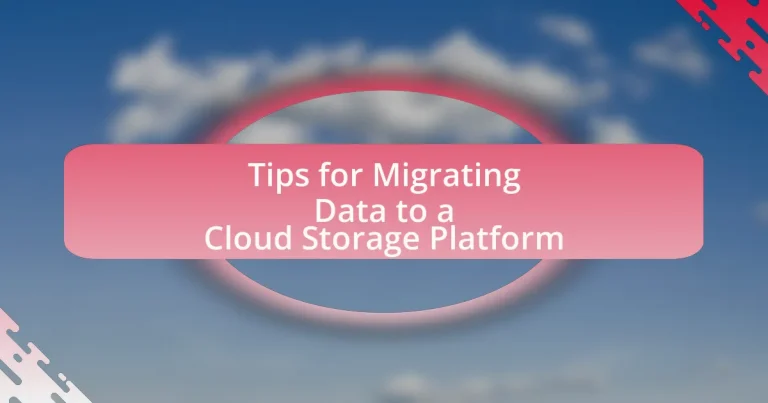The article focuses on essential tips for migrating data to a cloud storage platform, emphasizing key considerations such as data security, compliance, transfer speed, and cost management. It highlights the importance of data migration for businesses, detailing the risks of not migrating, including data loss and security vulnerabilities. The article also discusses the types of data that can be migrated, the differences between structured and unstructured data, and the tools available for assessment and planning. Additionally, it outlines best practices for ensuring a successful migration process, including thorough planning, testing, and post-migration management strategies to maintain data integrity and optimize cloud storage usage.
What are the key considerations for migrating data to a cloud storage platform?
Key considerations for migrating data to a cloud storage platform include data security, compliance with regulations, data transfer speed, and cost management. Data security is crucial as it involves protecting sensitive information from unauthorized access; for instance, using encryption during transfer and at rest can mitigate risks. Compliance with regulations, such as GDPR or HIPAA, ensures that the migration adheres to legal standards, which is essential for avoiding penalties. Data transfer speed affects how quickly data can be accessed post-migration, making it important to assess bandwidth and network capabilities. Lastly, cost management involves evaluating the pricing models of cloud providers to avoid unexpected expenses, as cloud storage costs can escalate based on usage and data retrieval.
Why is data migration important for businesses?
Data migration is important for businesses because it enables the transfer of data between storage systems, ensuring that organizations can access, manage, and utilize their data effectively. This process is crucial for upgrading to more efficient systems, improving data accessibility, and enhancing overall operational efficiency. According to a study by IBM, companies that successfully migrate their data can reduce operational costs by up to 30% and improve data retrieval times significantly, which underscores the value of effective data migration strategies in maintaining competitive advantage.
What risks are associated with not migrating data?
Not migrating data poses significant risks, including data loss, security vulnerabilities, and compliance issues. Data loss can occur due to hardware failures or obsolescence of legacy systems, which may lead to irretrievable information. Security vulnerabilities arise from outdated systems that lack modern protections, making sensitive data more susceptible to breaches; for instance, a 2021 report indicated that 85% of organizations experienced a data breach due to outdated infrastructure. Compliance issues can also emerge, as regulations often require data to be stored in secure, accessible environments; failure to comply can result in hefty fines and legal repercussions.
How can data migration improve operational efficiency?
Data migration can improve operational efficiency by streamlining data access and enhancing system performance. When organizations migrate data to a more advanced cloud storage platform, they often experience faster data retrieval times and reduced latency, which directly contributes to improved productivity. For instance, a study by McKinsey & Company found that companies leveraging cloud solutions can achieve up to 20-30% faster data processing speeds compared to traditional on-premises systems. This increased speed allows employees to make quicker decisions and respond to customer needs more effectively, ultimately leading to enhanced operational workflows.
What types of data can be migrated to cloud storage?
Various types of data can be migrated to cloud storage, including documents, images, videos, databases, and application data. These data types are commonly stored in formats such as PDFs, JPEGs, MP4s, SQL databases, and application-specific files. The ability to migrate these diverse data types is supported by cloud storage providers, which typically offer compatibility with multiple file formats and data structures, ensuring seamless integration and accessibility.
How do structured and unstructured data differ in migration?
Structured data migration involves transferring data that is organized in a predefined format, such as databases or spreadsheets, making it easier to map and transform during the migration process. In contrast, unstructured data migration deals with data that lacks a specific format, such as emails, documents, and multimedia files, which complicates the extraction, transformation, and loading (ETL) processes due to its variability and lack of organization. The complexity of unstructured data migration often requires advanced tools and techniques, such as natural language processing and machine learning, to effectively categorize and manage the data during the migration to a cloud storage platform.
What data formats are commonly supported by cloud storage platforms?
Cloud storage platforms commonly support data formats such as documents (PDF, DOCX), images (JPEG, PNG), audio files (MP3, WAV), and video files (MP4, AVI). These formats are widely used due to their compatibility with various applications and devices, making them essential for users migrating data to cloud storage. For instance, according to a report by Gartner, over 90% of organizations utilize these formats for data storage and sharing, highlighting their prevalence in cloud environments.
What steps should be taken before initiating data migration?
Before initiating data migration, it is essential to conduct a thorough assessment of the existing data environment. This involves identifying the data to be migrated, understanding its structure, and evaluating its quality. Additionally, organizations should establish a clear migration strategy that includes defining objectives, selecting the appropriate tools, and determining the timeline for the migration process.
Furthermore, it is crucial to perform a risk assessment to identify potential challenges and develop a contingency plan. Engaging stakeholders and ensuring proper communication throughout the process will facilitate smoother execution. Finally, conducting a pilot migration can help identify issues before the full-scale migration, ensuring that the process is efficient and effective.
How can organizations assess their current data landscape?
Organizations can assess their current data landscape by conducting a comprehensive data inventory and analysis. This process involves identifying all data sources, types, and formats within the organization, as well as understanding data flow and usage patterns. By mapping out data assets, organizations can evaluate data quality, compliance with regulations, and alignment with business objectives. A study by Gartner indicates that organizations that perform regular data assessments are 30% more likely to achieve successful data management outcomes.
What tools are available for data assessment and planning?
Tools available for data assessment and planning include data profiling tools, data quality assessment tools, and data governance platforms. Data profiling tools, such as Talend and Informatica, help analyze data sources to understand their structure and quality. Data quality assessment tools, like Trifacta and Ataccama, evaluate the accuracy and completeness of data, ensuring it meets required standards. Data governance platforms, such as Collibra and Alation, facilitate the management of data assets and compliance with regulations. These tools collectively enhance the effectiveness of data migration to cloud storage platforms by ensuring data integrity and alignment with business objectives.
What are the common challenges faced during data migration?
Common challenges faced during data migration include data loss, data corruption, and compatibility issues. Data loss can occur due to inadequate backup processes or errors during transfer, leading to incomplete datasets. Data corruption may arise from software bugs or network interruptions, compromising data integrity. Compatibility issues often stem from differences in data formats or structures between the source and target systems, making it difficult to ensure seamless integration. According to a study by IBM, 70% of data migration projects experience significant challenges, highlighting the importance of thorough planning and testing to mitigate these risks.
How can data integrity be maintained during migration?
Data integrity can be maintained during migration by implementing thorough validation processes and using checksums. Validation processes ensure that data is accurately transferred by comparing the source and destination data for discrepancies. Checksums, which are unique values generated from data sets, can be used to verify that the data remains unchanged during the transfer. According to a study by the National Institute of Standards and Technology, using checksums can reduce data corruption risks by up to 99%. Additionally, conducting regular audits post-migration further confirms that data integrity is upheld throughout the process.
What strategies can be employed to minimize downtime?
To minimize downtime during data migration to a cloud storage platform, organizations can implement strategies such as thorough planning, utilizing parallel processing, and conducting pilot tests. Thorough planning involves creating a detailed migration roadmap that outlines timelines, resource allocation, and potential risks, which helps in anticipating issues before they arise. Utilizing parallel processing allows multiple data transfers to occur simultaneously, significantly reducing the overall migration time. Conducting pilot tests enables organizations to identify and resolve any technical challenges in a controlled environment before executing the full migration, thereby minimizing unexpected disruptions. These strategies are supported by industry best practices, which emphasize the importance of preparation and testing in successful data migration projects.
How can organizations ensure a successful data migration process?
Organizations can ensure a successful data migration process by implementing a comprehensive migration strategy that includes thorough planning, data assessment, and testing. A well-defined strategy allows organizations to identify the scope of the migration, assess data quality, and determine the necessary resources and timelines. According to a study by Gartner, 70% of data migration projects fail due to inadequate planning and execution, highlighting the importance of a structured approach. Additionally, conducting pilot tests can help identify potential issues before full-scale migration, further increasing the likelihood of success.
What role does a migration strategy play in success?
A migration strategy is crucial for success as it provides a structured approach to transferring data, minimizing risks and ensuring data integrity. By outlining clear objectives, timelines, and resource allocations, a well-defined migration strategy helps organizations avoid common pitfalls such as data loss or downtime. Research indicates that organizations with a comprehensive migration plan experience up to 30% faster implementation times and significantly lower costs associated with data migration, as evidenced by a study from the Cloud Industry Forum.
How can testing and validation improve migration outcomes?
Testing and validation can significantly improve migration outcomes by ensuring data integrity and functionality throughout the migration process. By systematically verifying that data is accurately transferred and remains usable, organizations can identify and rectify issues before they escalate, thereby minimizing downtime and data loss. For instance, a study by the International Data Corporation (IDC) found that organizations that implemented thorough testing during cloud migrations experienced 30% fewer post-migration issues compared to those that did not. This proactive approach not only enhances the reliability of the migration but also boosts user confidence in the new system.
What are the best practices for post-migration management?
The best practices for post-migration management include conducting thorough validation of data integrity, monitoring system performance, and ensuring user training and support. Validation of data integrity involves comparing pre-migration and post-migration data to confirm accuracy and completeness, which is essential for maintaining trust in the new system. Monitoring system performance helps identify any issues that may arise after migration, allowing for timely adjustments to optimize functionality. Additionally, providing user training and support ensures that all stakeholders can effectively utilize the new cloud storage platform, which is critical for maximizing the benefits of the migration. These practices are supported by industry standards that emphasize the importance of data accuracy, system reliability, and user engagement in successful cloud migrations.
How can organizations monitor data integrity after migration?
Organizations can monitor data integrity after migration by implementing automated validation processes and regular audits. Automated validation processes involve using checksum algorithms to compare the original data with the migrated data, ensuring that no corruption or loss occurred during the transfer. Regular audits, which can include sampling data sets and reviewing logs, help identify discrepancies and maintain ongoing oversight of data integrity. According to a study by the International Journal of Information Management, organizations that utilize these methods report a 30% reduction in data integrity issues post-migration, highlighting the effectiveness of these monitoring strategies.
What steps should be taken to optimize cloud storage usage?
To optimize cloud storage usage, implement data classification and tiering strategies. Data classification involves categorizing data based on its importance and frequency of access, allowing organizations to prioritize storage resources effectively. For instance, frequently accessed data can be stored in high-performance tiers, while infrequently accessed data can be moved to lower-cost storage options. According to a study by Gartner, organizations can reduce storage costs by up to 30% through effective data tiering. Additionally, regularly reviewing and deleting unnecessary files can further enhance storage efficiency, as it prevents the accumulation of redundant data.
What tools and resources are available for data migration?
Data migration tools and resources include software solutions like AWS Database Migration Service, Azure Migrate, and Google Cloud Data Transfer Service. These tools facilitate the transfer of data between on-premises and cloud environments, ensuring minimal downtime and data integrity. For instance, AWS Database Migration Service supports various database engines and automates much of the migration process, which is crucial for large-scale data transfers. Additionally, resources such as documentation, community forums, and professional services from cloud providers enhance the migration process by offering guidance and support.
How do cloud migration services differ from traditional methods?
Cloud migration services differ from traditional methods primarily in their approach to data transfer and infrastructure management. While traditional methods often involve manual processes, on-premises hardware, and significant downtime, cloud migration services utilize automated tools, scalable resources, and minimal disruption to operations. For instance, cloud migration can leverage APIs and cloud-native services to facilitate real-time data synchronization, which contrasts with the slower, more labor-intensive processes of traditional methods that may require extensive planning and physical hardware adjustments. This efficiency is supported by the increasing adoption of cloud technologies, with a report from Gartner indicating that by 2025, 80% of enterprises will have migrated to the cloud, highlighting a significant shift in how organizations manage their data and infrastructure.
What are the top-rated tools for cloud data migration?
The top-rated tools for cloud data migration include AWS Migration Hub, Google Cloud Data Transfer Service, and Azure Migrate. AWS Migration Hub provides a central location to track the progress of application migrations across multiple AWS and partner solutions. Google Cloud Data Transfer Service allows users to transfer data from on-premises storage or other cloud providers to Google Cloud Storage efficiently. Azure Migrate offers a comprehensive solution for assessing and migrating on-premises workloads to Azure, integrating various tools for different migration scenarios. These tools are widely recognized for their effectiveness and user satisfaction in facilitating seamless cloud data migration.
What are the common pitfalls to avoid during data migration?
Common pitfalls to avoid during data migration include inadequate planning, lack of data validation, and insufficient testing. Inadequate planning can lead to missed deadlines and budget overruns, as organizations often underestimate the complexity of the migration process. Lack of data validation may result in transferring corrupted or incomplete data, which can compromise the integrity of the new system. Insufficient testing before going live can cause unexpected issues, leading to downtime and loss of productivity. According to a study by the Data Migration Institute, 83% of organizations that fail to validate their data experience significant problems post-migration, highlighting the importance of thorough preparation and testing.
How can lack of planning lead to migration failures?
Lack of planning can lead to migration failures by causing misalignment between business objectives and technical execution. When organizations fail to establish clear goals, assess their current infrastructure, and identify potential risks, they often encounter issues such as data loss, downtime, and increased costs. For instance, a study by the Cloud Industry Forum found that 60% of cloud migration projects experience delays due to inadequate planning and resource allocation. This highlights the critical need for a structured approach to ensure successful data migration to cloud storage platforms.
What are the consequences of ignoring compliance requirements?
Ignoring compliance requirements can lead to severe legal and financial repercussions for organizations. Non-compliance may result in hefty fines, legal action, and damage to reputation, as evidenced by the General Data Protection Regulation (GDPR), which imposes fines of up to 4% of annual global turnover for violations. Additionally, organizations may face increased scrutiny from regulatory bodies, loss of customer trust, and potential operational disruptions, as compliance is often tied to data security and privacy standards essential for maintaining business continuity.
What practical tips can help ensure a smooth data migration?
To ensure a smooth data migration, it is essential to conduct thorough planning and testing before the actual migration process. This involves creating a detailed migration strategy that outlines the steps, timelines, and resources required. Additionally, performing a pilot migration with a small subset of data can help identify potential issues and allow for adjustments before the full-scale migration. According to a study by the Cloud Industry Forum, 70% of organizations that conducted pre-migration testing reported fewer issues during the actual migration. Furthermore, maintaining clear communication among all stakeholders throughout the process is crucial for addressing concerns and ensuring alignment.


